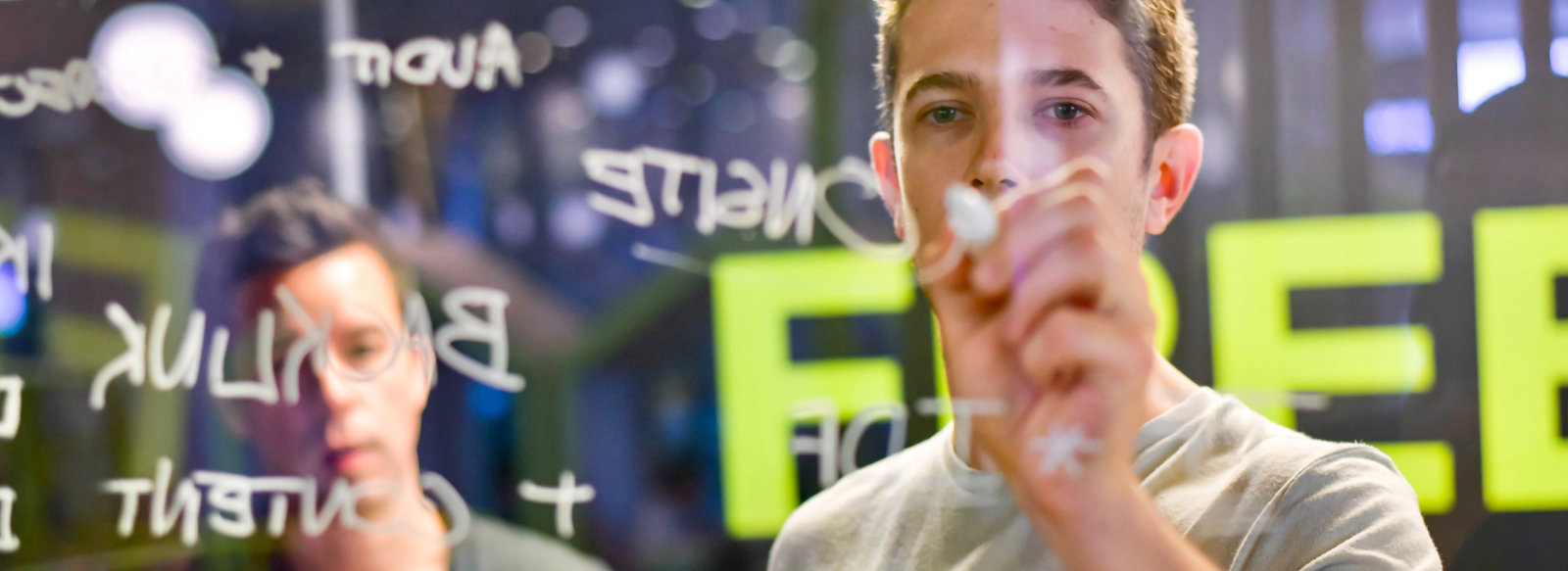Ever have the sense of scaling a sharp incline, and just when you think it’s been surmounted another summit appears? That’s what enterprise UX design challenges can feel like.
Unlike consumer design that focuses on simplicity and ease of use, enterprise UX is a different beast. Enterprise UX design challenges add layers of complexity that require strategic navigation and innovative solutions.
Surely though, there must be some way to balance this complexity while maintaining efficiency and productivity? And if so, how do we embrace innovation without compromising familiarity?
Intriguing questions indeed! As we navigate through these peaks together in this post, I promise – not only will it get less daunting but also quite enlightening!
Understanding Enterprise UX Design
Enterprise User Experience (UX) design is a distinct breed, catering to professionals in the workplace. It’s not just about making things look good – it’s about creating intuitive and efficient systems that empower users to accomplish complex tasks.
The Crucial Role of Power Users in Enterprise UX design Challenges
In an enterprise setting, you often encounter power users who interact with niche software on a daily basis. They’re the people to turn to for difficult issues or when in-depth knowledge is needed.
Interestingly enough, these individuals have different needs compared to casual users. More than anyone else within the organization, they value off-page instructions for more comprehensive explanations [#]. This preference comes from their drive for mastery over the tools they use every day which is crucial in addressing enterprise UX design challenges.
The Acceptance of Steep Learning Curves
Moving on, we find another unique characteristic: The acceptance of steep learning curves in enterprise UX design. But why?
To start with, this phenomenon isn’t as counter-intuitive as it seems at first glance [#].
You see, if given adequate time and re#s to learn new systems thoroughly, employees can extract massive benefits out of intricate features tailored specifically for their job role—a trade-off between initial effort and long-term productivity gains in the realm of enterprise UX design challenges.
The Complexity of Enterprise UX Design Challenges
It’s important to mention that overly simplifying enterprise UX design challenges can actually hinder users’ ability to perform complex tasks and access vital features. After all, we’re dealing with professionals who are often handling intricate workflows.
Non-linear flows present a significant challenge in this realm [#]. They need to accommodate different roles, responsibilities, and user preferences—a delicate balancing act for any designer.
Striking the Right Balance: Navigating Innovation and Familiarity in Enterprise UX Design Challenges
Let us further investigate this issue.
Key Takeaway:
However, we must be cautious not to oversimplify these designs. Doing so could actually hamper performance and restrict access to key features. This is because professional workflows often require a level of complexity that can’t simply be stripped away without consequence.
Balancing Complexity and Usability: The Core Enterprise UX Design Challenge
Constructing an intuitive user experience for enterprise applications is akin to generating a comprehensible map of a vibrant metropolis. You can’t just strip away all the complexity; you need it to navigate through intricate tasks and access essential features. This balance between complexity and usability is at the heart of the enterprise UX design challenges
Studies have shown that oversimplifying enterprise UX design can actually hinder users’ ability to perform complex tasks and access vital features. It’s akin to removing key landmarks from our city map, leaving people lost when they’re looking for specific destinations.
The Challenge of Non-Linear Flows
In most consumer applications, there’s typically one optimal path or ‘flow’ which guides users towards their goal. But designing non-linear flows in enterprise UX requires more flexibility because different roles, responsibilities, and user preferences call for varied routes across the application landscape presenting unique enterprise UX design challenges.
This might sound confusing but think about how we use cities again. Everyone doesn’t take the same route every day – some are commuting to work while others might be going shopping or visiting friends – similarly different roles within an organization will interact with software differently based on their needs.
A task analysis study found that crafting these diverse paths is challenging but absolutely necessary as they accommodate different roles and responsibilities within an organization alongside catering to individual user preferences. This diversity highlights the enterprise ux design challenges of creating software that meets the needs of various users within an organization.
So, let’s put this into perspective: If you’re tasked with directing traffic flow in our bustling city, you wouldn’t simply funnel everyone down one road. That would cause a traffic jam and hinder productivity. Instead, you’d want to create multiple routes that cater to the various needs of your citizens – this is what non-linear flow design aims for in enterprise UX challenges.
Designing these flows can be likened to designing complex public transport systems – each route serves a purpose and allows users (or passengers) to reach their desired destination efficiently without unnecessary detours.
lines. Creating a system that’s complex, yet feels simple and straightforward to use—that’s the fascinating puzzle we’re trying to solve in enterprise UX design.
Key Takeaway:
The ultimate goal? A user-friendly system that meets the diverse needs of an organization. Its about tackling enterprise UX challenges ,where complexity doesn’t become confusion, and every role finds its unique path. Just like a well-planned city, each route is tailored to serve its citizens efficiently.
Innovation vs Familiarity: Tackling Enterprise UX Design Challenges
When we think about enterprise UX design challenges, a battle often comes to mind. It’s the clash between innovation and familiarity.
In the quest to create cutting-edge solutions, there’s a risk of alienating users who are accustomed to familiar interfaces. Striking the right balance is key – introducing innovative features while maintaining enough familiarity to ensure usability and efficiency. This delicate dance is at the core of the enterprise UX design challenge.
The world of technology is constantly evolving, with new trends emerging every day. This creates a pull towards incorporating innovative features into our designs. The Future Of Enterprise Software Is In User Experience. But there’s also a push from users who value familiarity and productivity over flashy, unproven elements.
Statistically speaking, it has been observed that too much innovation in enterprise software can disrupt user workflows and reduce overall efficiency. So what do we do? Let’s explore this delicate balance further.
Balancing Innovation and Familiarity
“Don’t mess with success” is a common expression. When designing for an enterprise context, this couldn’t be more relevant. After all, these are tools professionals use daily to complete tasks efficiently – any change can impact their workflow significantly highlighting the importance of addressing enterprise UX challenges.
Familiar interfaces give users confidence as they navigate through complex systems; making them feel like they’re operating within safe boundaries where everything works as expected. Why User Experience Matters to Marketing.
This doesn’t mean you should resist innovating entirely though. Rather than reinventing the wheel each time around; consider adding layers of functionality or enhancing existing ones instead. 7 Great, Tried and Tested UX Research Techniques.
Innovation in Context
It’s key to stay alert for emerging trends, even if they aren’t disruptive. A fresh feature or design approach could make a big difference in user experience without shaking things up too much. To learn more about the distinction between disruptive and sustaining innovations, check out this article.

Enterprise UX Design Challenges: Overcoming Stagnation
It’s widely recognized that enterprise users frequently encounter sub-optimal user experiences (UX). The main reason? Large companies tend not to change their software frequently, leaving employees stuck with outdated and clunky interfaces. Research shows this has led many users to become accustomed – albeit reluctantly – to bad UX.
However, by actively addressing these enterprise UX design challenges, organizations can shift towards more user-centric designs, ultimately enhancing productivity and user satisfaction.
The Expected Shift Towards Great UX
Don’t worry, there’s hope yet. As the world becomes more digitally savvy, there’s an expected shift on the horizon towards great UX in enterprise software. Firms are beginning to recognize that optimizing their systems can result in amplified efficiency and more contented personnel.
To give you an idea: Imagine going from riding a horse-drawn carriage every day – slow, uncomfortable and frustrating – suddenly being handed keys for a sleek sports car – fast, comfortable, efficient. That’s what we’re talking about when we mention shifting towards better enterprise software experience.
A study by Forrester Research showed that implementing good design could increase conversions by up to 200%. Now think about applying these figures within your organization; it would mean massive improvements in employee efficiency and overall business performance highlighting the importance of addressing enterprise UX design challenges
You may ask why hasn’t everyone jumped onto this bandwagon already then? Well, making changes in large organizations is akin to turning around an oil tanker—it takes time. However rest assured change is coming.
Spotting Signs of Change
In our work as an Enterprise UX Design Agency, we’ve started noticing more and more businesses asking how they can improve their software interfaces. It’s like a breath of fresh air in an otherwise stagnant room.
Another sign is the rise of user-centered design roles within companies. Businesses are starting to understand that good design isn’t just about aesthetics—it’s about creating something useful, efficient, and enjoyable for its users.
Moving Forward with Better Enterprise UX
We’ve started the process, setting things in motion. Let’s see where this journey takes us.
Key Takeaway:
Progress is definitely happening in addressing enterprise ux design challenges. We’re seeing a shift towards user-friendly designs and intuitive interfaces that cater to employees’ needs. It’s like upgrading from an old, rickety horse-drawn carriage to the sleek efficiency of a sports car. Although turning this “oil tanker” can be slow-going, it’s clear that enterprise UX is heading in the right direction.
Innovative Strategies for Overcoming Enterprise UX Design Challenges
Improving enterprise UX design can be a complex task, but don’t fret. With the right strategies and understanding of users’ needs, it’s more than achievable.
Making Use of Power Users
The first step to enhancing your enterprise UX is recognizing the role power users play in this sphere. Unlike typical consumers, enterprise users interact with niche software on a daily basis. This interaction means they often prefer off-page instructions for more detailed explanations.
A way to cater to these power users is by designing user interfaces that allow them room to explore and become proficient over time. Remember though; there’s no one-size-fits-all approach here as each business has unique requirements and challenges.
Navigating Through Learning Curves
An interesting aspect of enterprise UX design is the acceptance of steep learning curves which is a key aspect of addressing enterprise UX challenges. It may appear odd to some that complex programs are desired; why would anyone want a challenging program? But in reality, once invested time into mastering an intricate tool or system enables professionals to work efficiently. Products with steep learning curves can indeed be beneficial in enterprise environments.
Simplicity vs Complexity: Striking The Balance
Simplifying interface designs might sound like an obvious solution – but hold on. Oversimplified designs could hinder the ability to perform complex tasks or access vital features needed by your team members.
To navigate this issue successfully requires designing non-linear flows tailored towards accommodating different roles, responsibilities within organizations effectively. Here’s a piece that delves into the necessity of such designs.
Innovation vs Familiarity: A Delicate Balance
The tightrope between innovation and familiarity in enterprise UX design is another challenge. While fresh, innovative interfaces can add value, they must be approached with caution. Enterprise software values productivity and familiarity above all else – so it’s essential to keep this balance in mind during your design process.
Key Takeaway:
Striking a balance between usability and functionality is key. It’s all about providing an experience that satisfies the needs of power users, without compromising on comprehensive features. Remember, while mastering complex systems may be challenging at first, it allows professionals to work more efficiently down the line.
Read: Revolutionizing Enterprise UX Design: The Intersection of AI
FAQs in Relation to Enterprise Ux Design Challenges and Best Practices
What are some of the biggest challenges you face as a UX designer?
Navigating complex workflows, balancing innovation with familiarity, and designing for diverse power user roles top the list.
What are the 4 C’s of UX design?
The 4C’s: Consistency for seamless interaction; Clarity to ensure ease-of-use; Control offering users choices; and Contextual relevance within user environments.
What were the challenges that he encountered as a UX designer?
Besides learning curves in enterprise software, dealing with non-linear flows and frequent bad UI experiences pose big hurdles too.
What is best practices in UX design?
Focusing on usability, keeping interfaces simple yet functional, considering system feedback timeframes and conducting regular user testing form part of best practices.
Conclusion
Enterprise UX design, huh? It’s a climb but one worth making. ️
Power users and their unique needs… steep learning curves that ultimately pay off in productivity. These are the hallmarks of enterprise UX.
We’ve seen how oversimplifying can backfire – complexity has its place! Especially when dealing with non-linear flows designed to accommodate diverse roles and responsibilities.
Innovation vs familiarity is a delicate balance in Enterprise UX Design Challenges and Best Practices, isn’t it?
The status quo might be bad UX now, but hold tight! A shift towards better user experience is on the horizon!
So there you have it – your mountain guide for tackling Enterprise UX Design Challenges. Now go forth and conquer those peaks!




